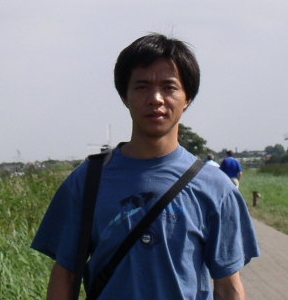
Ph. D Student on Computer Science
Affiliations
Telephone
Fax
ENIC - Telecom Lille 1
MIIRE and
Université des Sciences et Technologies de Lille
[email protected]
+1-410-516-8258
+1-410-516-4594

|
|
Short-term Visiting Scholar Ph. D Student on Computer Science Affiliations Telephone Fax |
Center for Imaging Science at
The Johns Hopkins University
ENIC - Telecom Lille 1 MIIRE and Université des Sciences et Technologies de Lille [email protected] +1-410-516-8258 +1-410-516-4594 |
| Biosketch | I am a Ph. D student in ENIC - Telecom Lille 1 (Lille, France)
in the third year. I am on the MIIRE team. I got my Master's
Degree in Engineering in Zhongshan University
(Canton, China). Then I worked in China Telecom for more
than two years. I am currently a short-term visiting scholar at
the Center for Imaging Science
at The Johns Hopkins University. Please see my vitae for details. |
| Ph.D Research | I have been working on statistical modeling applied
to detecting skin and blocking adult images in my Ph. D study. Much
of the work is accompanied with the POESIA project, which aims to
protect European children from unhealthy web content through many novel content-based
techniques. You are welcome to download and try this free software from
http://sourceforge.net/projects/poesia. In view of the correlation between adult images and large skin patches, we have to design a skin detector. We build a sequence of statistical models with Maximum Entropy Modeling. The first model, called Baseline Model in our work, applys constraints on individual pixels' color and label. The resulting model considers pixels to be independent, which has been implemented in Jones&Rehg's work. The constraints of this model is certainly too loose since generally skin pixels tend to appear together and form special shapes. So we augmented the constraints to include two-site marginal of labels. The resulting model is a Hidden Markov Model. The last model is the First Order Model, in which we go further to include the color gradients as the constraints since we hope the changes in neighboring colors help discriminate skin pixels from non-skin ones. The resultig model is a pair-wise Markov Random Field (MRF). Parameter estimation cannot be tackled straightforwardly. With tree approximations of the local pixel lattice, we get simple analytical expressions for the statistical model. We experimented various stochastic methods such as Gibbs sampling and Belief Propagation, for probability inference on pixel locations. Our experiments show that Belief Propagation perform as well as Gibbs sampling in terms of pixel classification errors, and it is much faster in practice. The output of skin detection is a greyscale skin map with the grey level indicating the belief of skin. We then calculate several simple features from this map which form a feature vector. Most of these features are based on fit ellipses, which are used to catch the characteristics of detected skin regions. The motivation of using fit ellipses is to discriminate portaits from adult images since this is the most difficult case from the experience of our experiments. Two fit ellipses are used for each skin map---the fit ellipse of all skin regions and the fit ellipse of the largest skin region. They are called respectively Global Fit Ellipse and Local Fit Ellipse in our work. A multi-layer perceptron classifier is then trained for these features. Experimental results based on a large test set show stimulating performance for such simple features. |
| Selected Papers | B. Jedynak, H. Zheng and M. Daoudi, Improving skin detection with higher order models
, in revision, submitted to Image and Vision
Computing. H. Zheng, M. Daoudi and B. Jedynak, Blocking adult images based on statistical skin detection , in revision H. Zheng, H. Liu and M. Daoudi, Blocking objectionable images: adult images and harmful symbols, The 2004 IEEE International Conference on Multimedia and Expo(ICME’2004), Taipei, Taiwan, June 27th – 30th, 2004. B. Jedynak, H. Zheng, M. Daoudi, Maximum entropy models for skin detection, International Workshop Energy Minimization Methods in Computer Vision and Pattern Recognition, EMMCVPR2003 Lisbon, Portugal, July 7th-9th, 2003. B. Jedynak, H. Zheng and M. Daoudi, Statistical models for skin detection , IEEE Workshop on Statistical Analysis in Computer Vision, June 22 2003. B. Jedynak, H. Zheng and M. Daoudi, Maximum entropy models for skin detection , Third Indian Conference On Computer Vision, Graphics and Image Processing, ICVGIP 2002, pp. 276-281, Ahmedabad, India, December 16-18 2002. |
| Advisors |
Mohamed Daoudi, Bruno Jedynak |